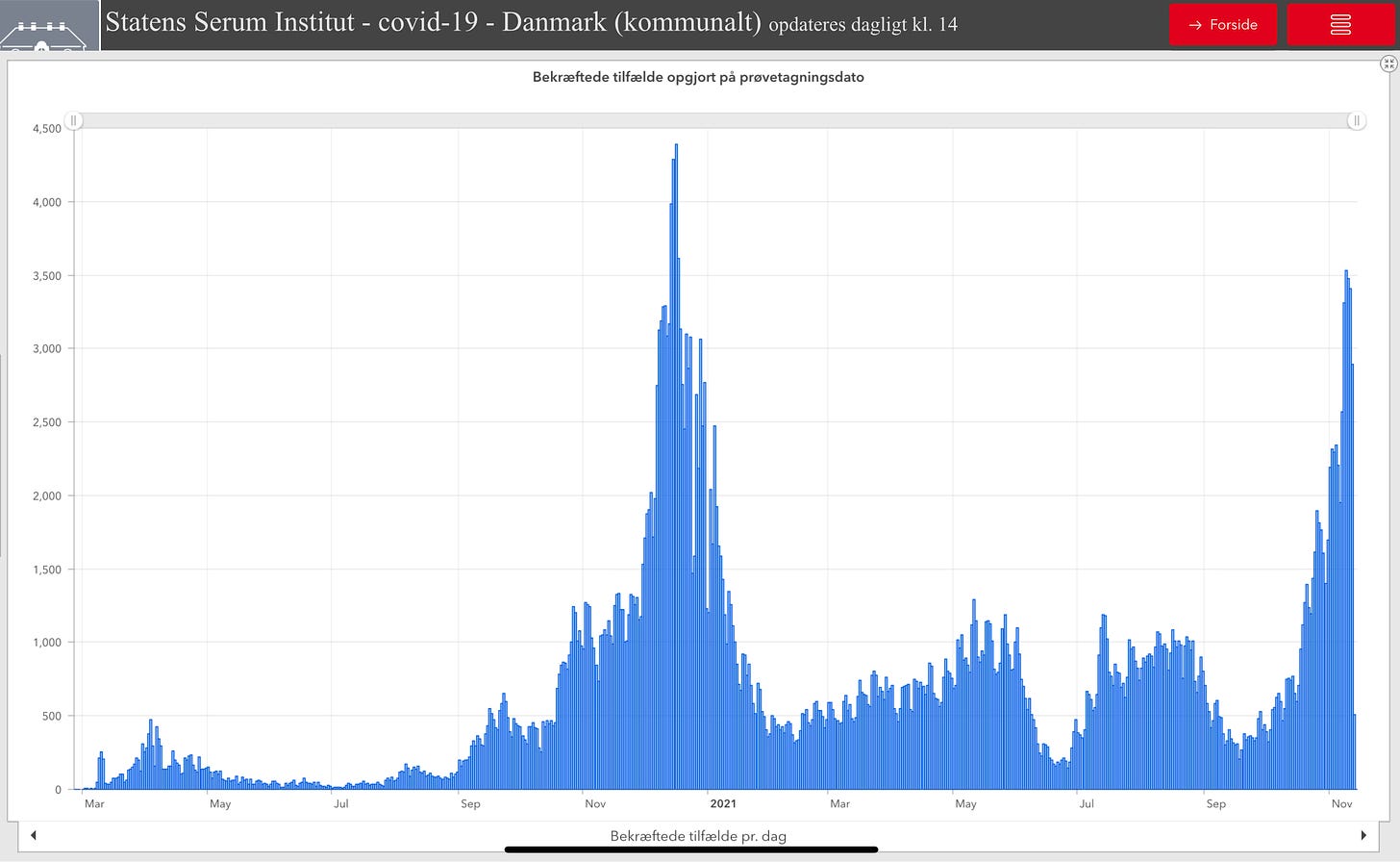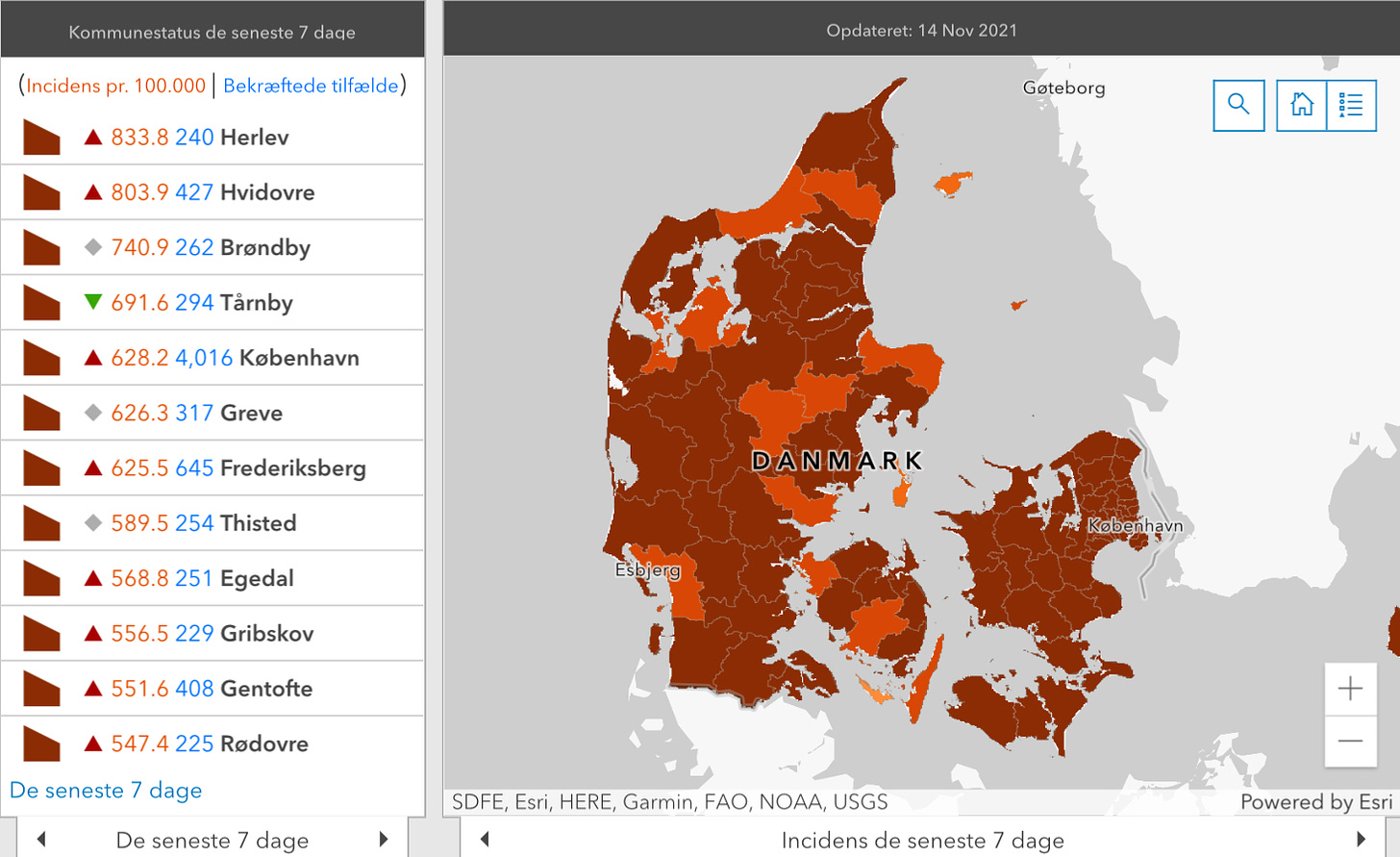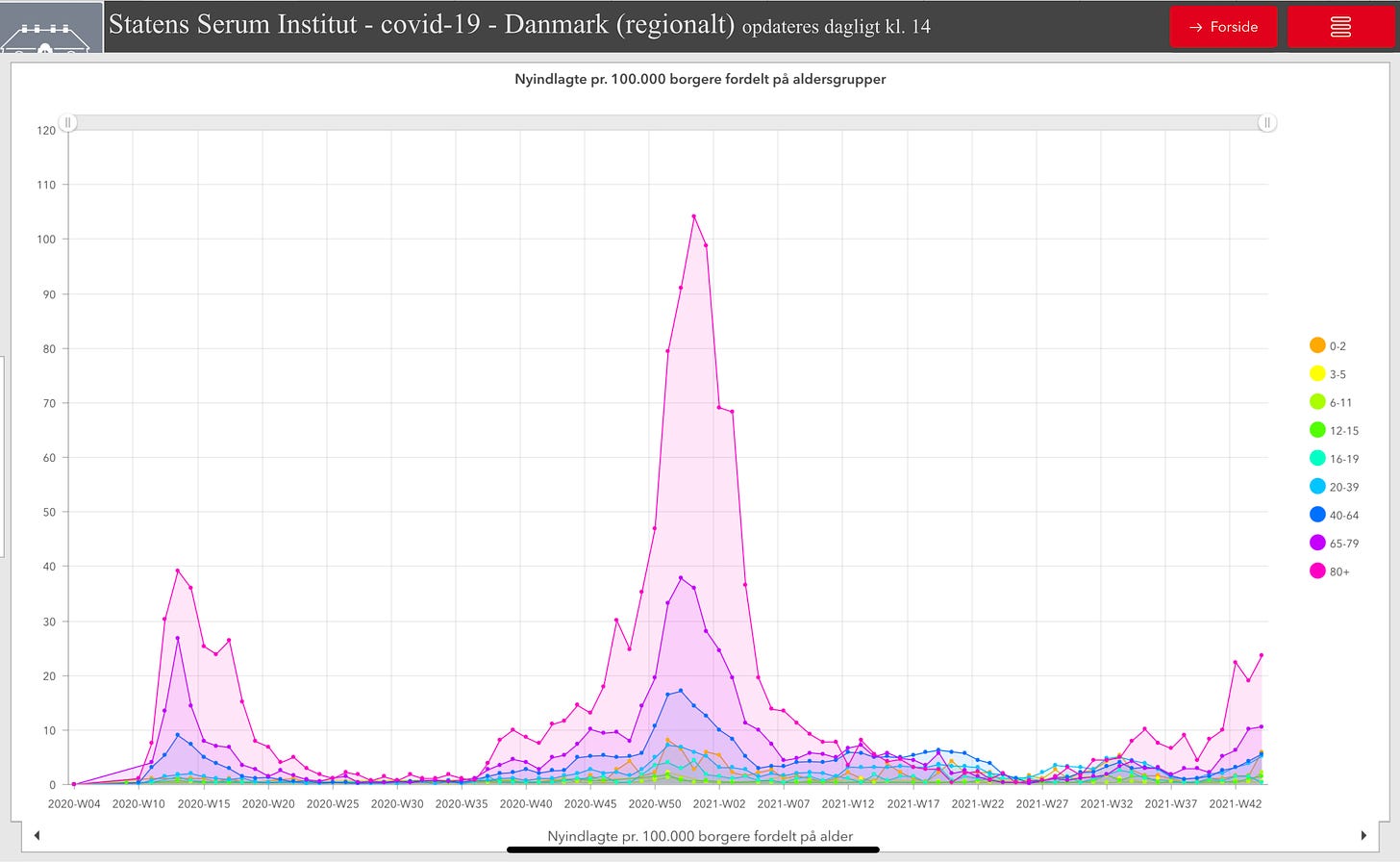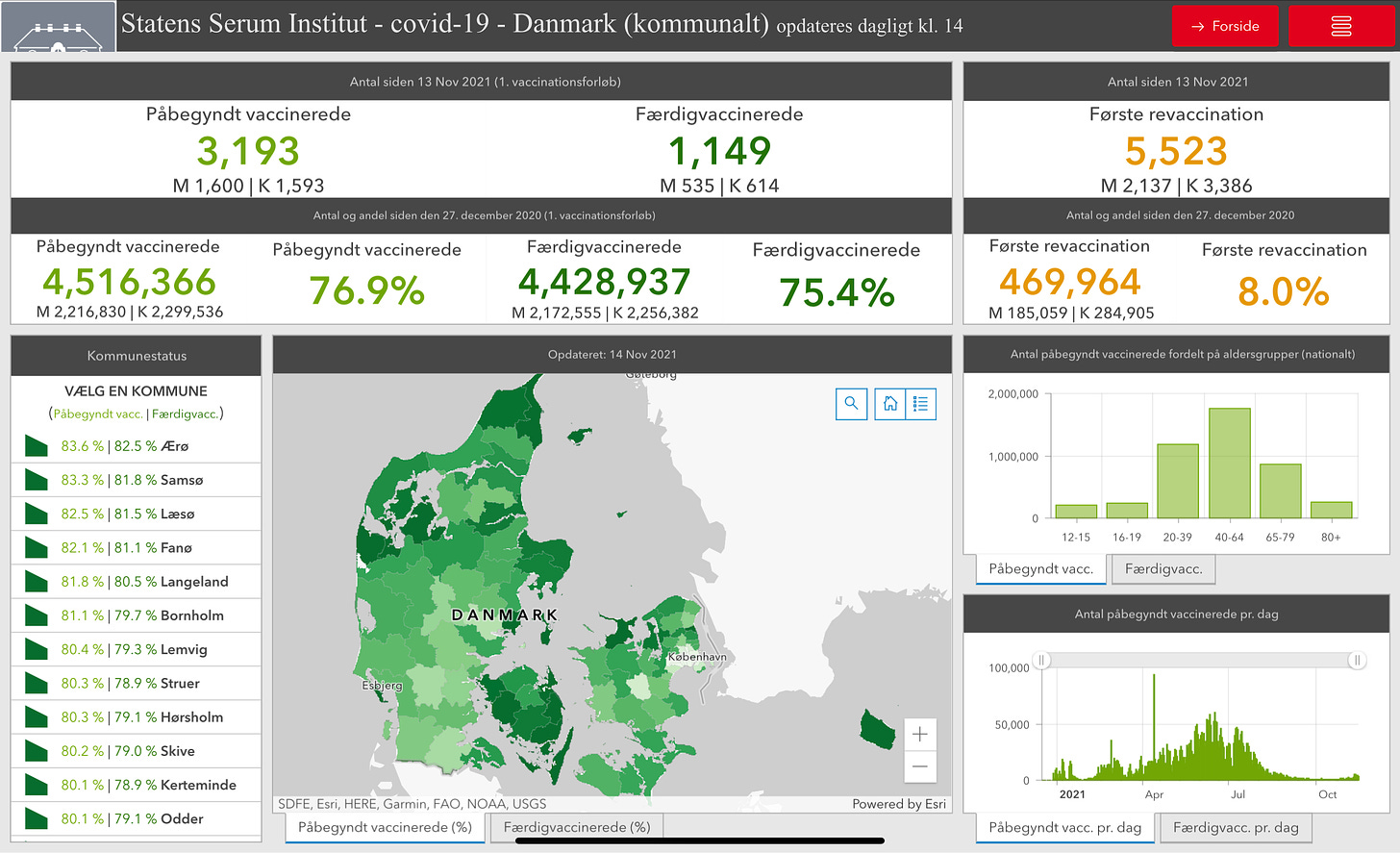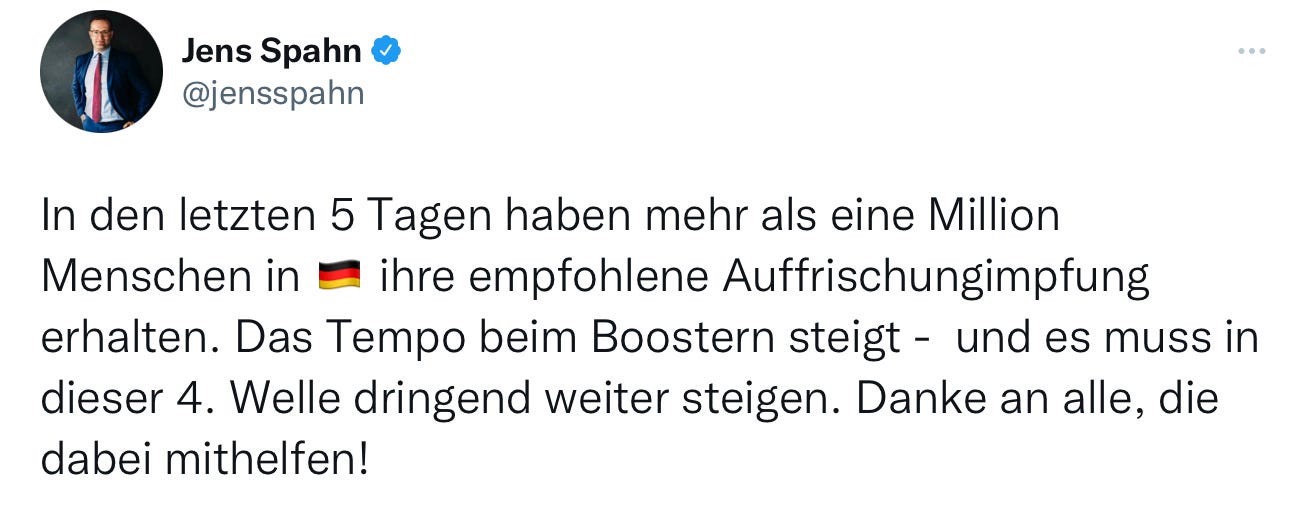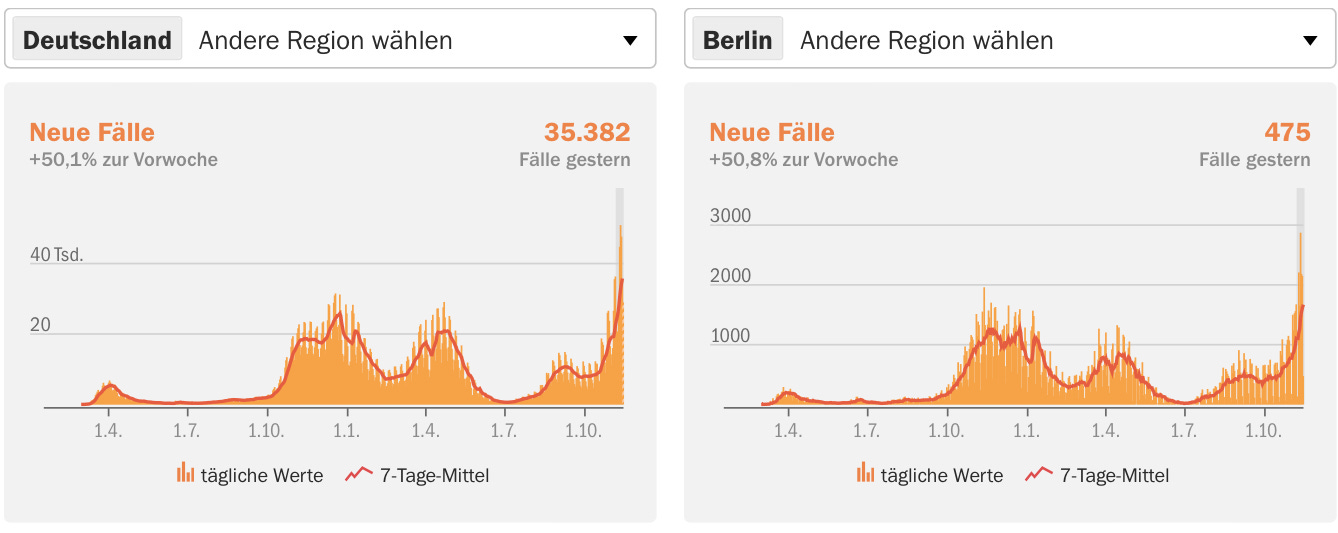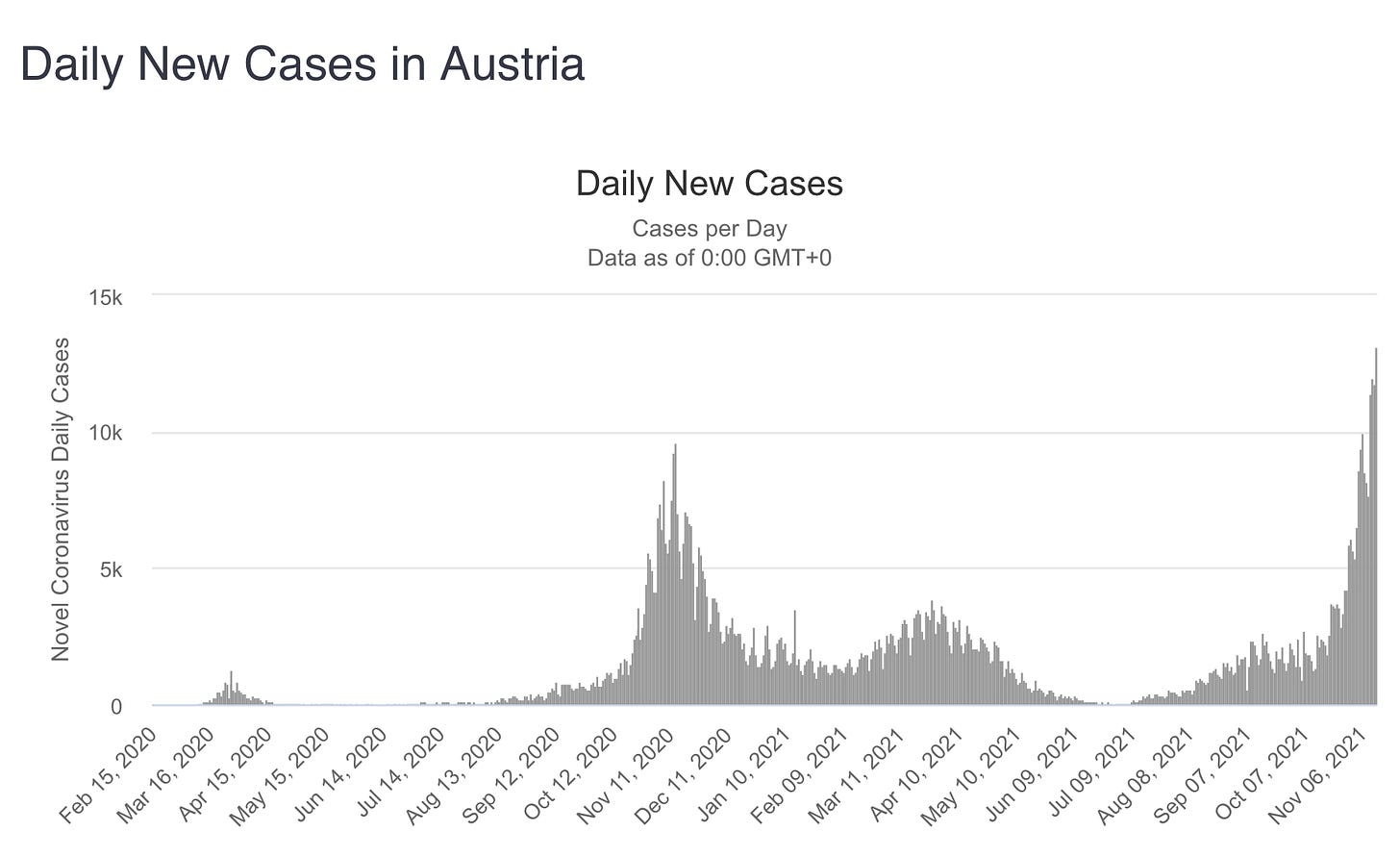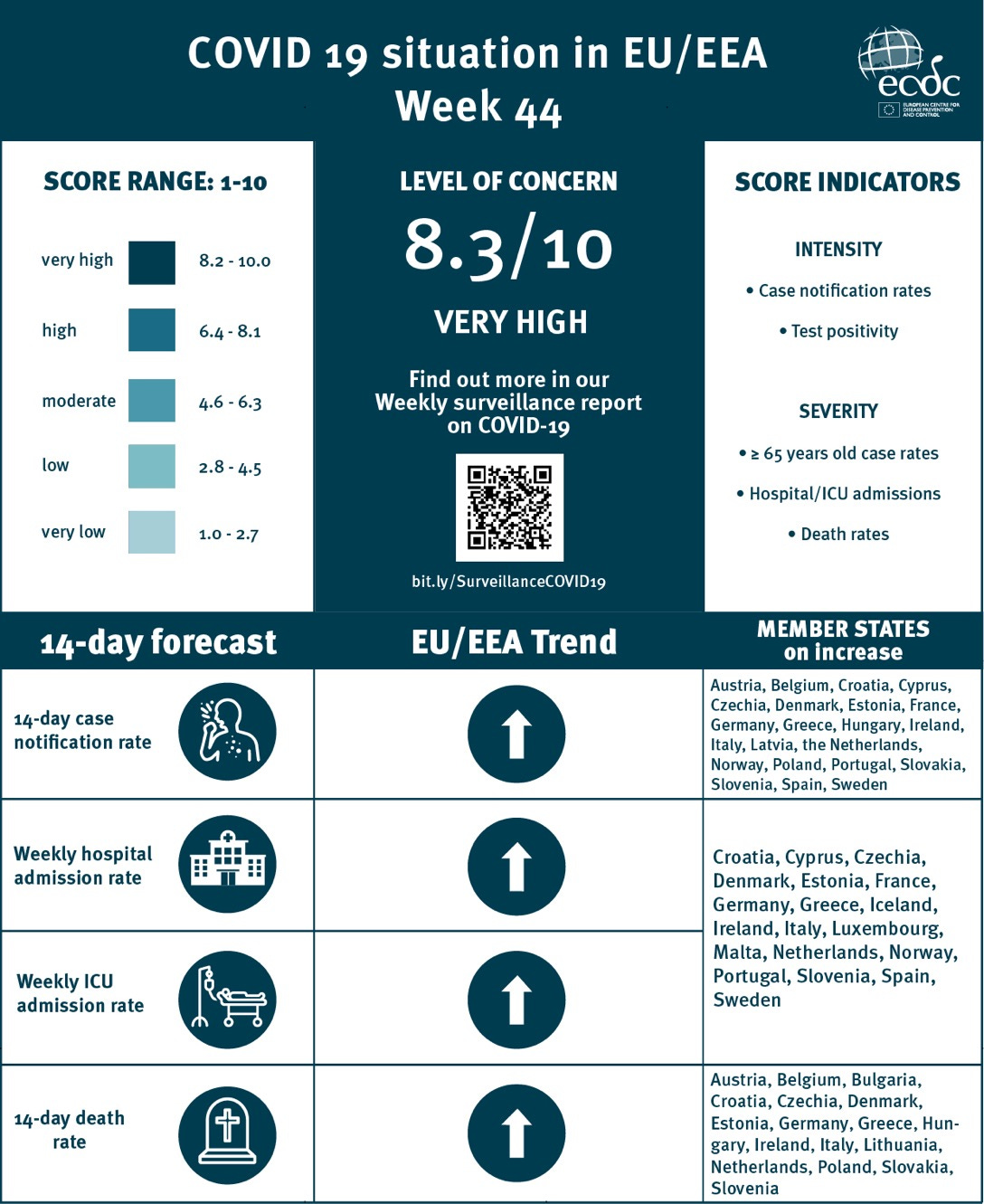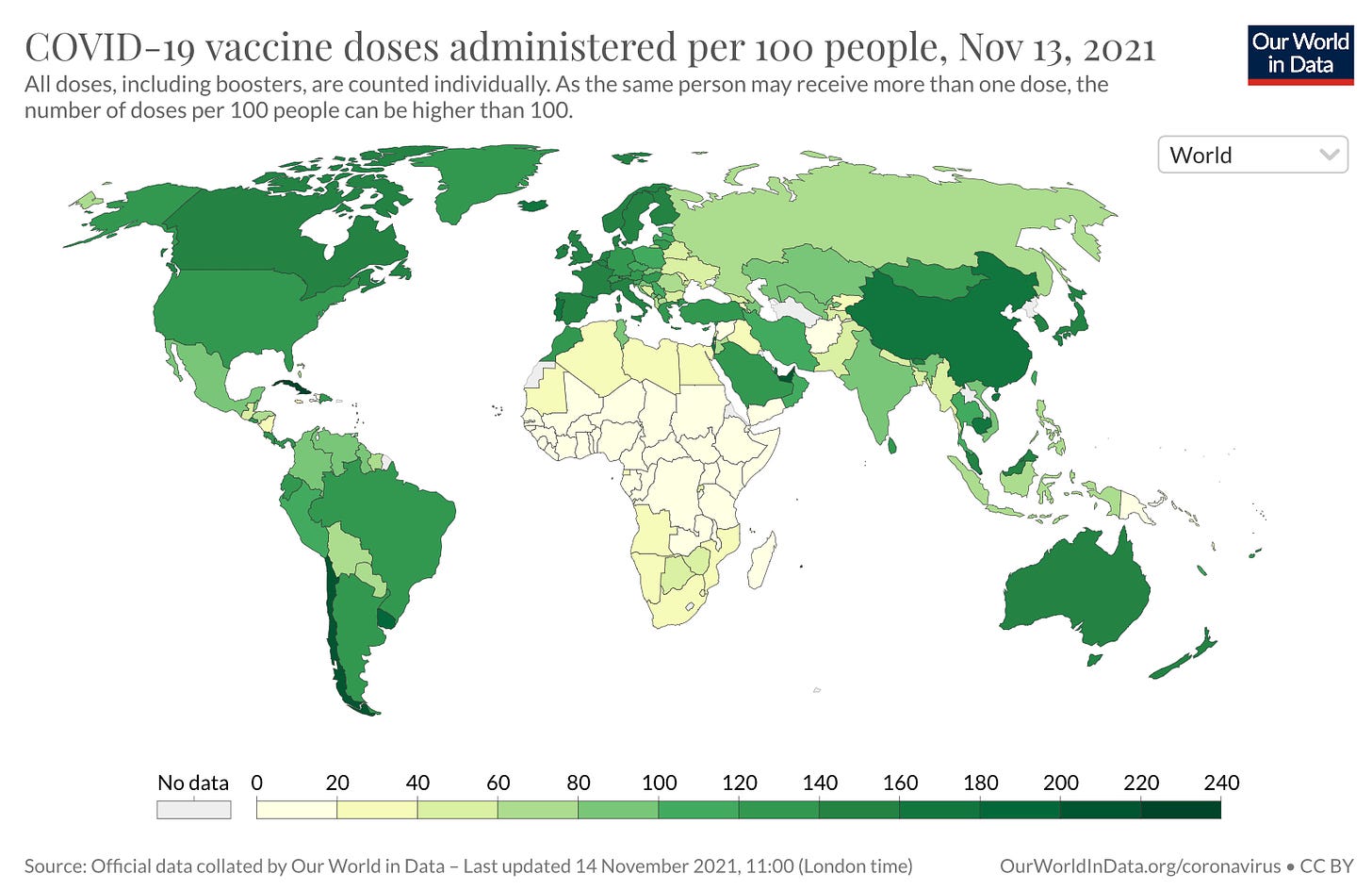🇩🇰
The number of breakthrough infections among fully vaccinated people in Denmark continues to rise but overall remains a very small percentage. In its latest report on breakthrough infections the Staten Serum Institut has confirmed infections in 38,587 fully vaccinated people. As a percentage of all vaccinated people that equates to 0.93%, up from 0.5% in the last update.
Of the breakthrough infections so far there have been 1,231 hospitalizations and 158 deaths.
Department Head Palle Valentiner-Branth:
“Overall, the number of breakthrough COVID infections is increasing. This reflects the fact that a majority of the people have been vaccinated. But also that we are seeing increasing infection pressure as the epidemic is grows. The increasing number of infections after vaccination may also be a sign that vaccine effectiveness is declining over time in some populations."
Conversely, the number of breakthrough infections among the people who have had a booster shot is extremely low. Of the 275,745 people who had a 3rd dose as of the end of last week there have been 277 breakthrough infections, or 0.1% of the population with three doses.
“The proportion of those revaccinated who have had an infection is extremely low. This is despite the fact that the pressure of infection has been high over the past month, and that the group of revaccinated people largely consists of vulnerable populations and seniors. This suggests that the revaccination provides good protection against infection.”
The latest report covers a period from when vaccinations began on December 27 up until last week.
-
Make it six. Lindehøjskolen in Herlev Kommune is seeing a coronavirus outbreak resulting in classes from 0 to 5 being closed and students sent home. The Danish Agency for Patient Safety confirmed the closure to DR. The other five schools are Herstedøster School in Albertslund, Dyvekeskolen and Strandparkskolen in Copenhagen, Læringshuset in Høje-Taastrup, and Brøndbyvester School in Brøndby. In order for the agency to issue an order closing a school, or classes within a school, it must consider the infection to be spreading out of control at the school in question.
-
It is not just schools activities in this month’s local government elections are also being impacted. The mayor of Vesthimmerland Municipality in North Jutland, Per Bach Laursen, told DR that a spiraling COVID incidence rate and a city councilor testing positive mean election events involving attendees or mixing with the public have all been cancelled.
In Aabenraa Kommune, Mayor Thomas Andresen, is largely pulling himself off the campaign trail due to his concern about getting infected. He says he won’t attend large events as he feels nervous about being in small spaces with large groups of people. He is even leaning toward skipping the traditional election night gathering when results are announced. He says he will still campaign on the streets and talk to people outside.
In Næstved, the kommune says COVID fears have led to a major surge of mail-in ballots saying they are “pouring in.” Election Manager Gitte Nonbo says they extended hours at mail-in ballot sites last week to accommodate the demand. KL, the National Association of Local Authorities, has called for all of Denmark’s municipalities to extend opening hours to allow people get in their ballots by mail due to the exploding infection rate.
-
Measures to reduce infection spread in municipalities, and districts within them, will now be triggered a little sooner. Denmark’s Mimistry of Health says the thresholds at the kommune and district level requiring COVID measures be initiated have been lowered. This follows a recommendation from Denmark’s Epidemic Commission last week.
As of today, the incidence rate triggering COVID counter measures in kommunes lowers from 500 to 400 per 100,000 residents.
At the parish level the infection incidence rate is reduced from 1,000 to 800.
Measures would include increasing testing capacity, targeted vaccination efforts, isolating classes in schools so they don’t mingle, and keeping parents outside to drop off and pick up their kids, etc.
-
Denmark added 10,756 COVID infections over the weekend while losing another 18 lives to the coronavirus. On Friday, it reported 4,585 infections, but remember due to a technical issue the day before that covered a 37 hour time period. On Saturday, there were another 2,948 cases followed by 3,223 on Sunday, the highest daily number of new infections since December 23rd of last year.
Yesterday, there were 239,192 total corona tests done, of which 158.514 were PCR tests equaling a positivity percentage of 2.03%.
-
Just three of Denmark’s 98 kommunes have COVID incidence rates less than 100 per 100,000 residents. The three are the islands of Ærø, Samsø, and Læsø. On the other end of the spectrum two municipalities, Herlev and Hvidovre, have now breached the 800 mark as Denmark turns almost entirely high-risk crimson.
-
As the coronapas returns the Danish Agency for Security of Supply says that will put more pressure back on COVID testing so it is increasing daily capacity. Over the weekend, the overall number of daily coronavirus tests across the country was raised to 370,000. Specifically, it means that the daily rapid testing capacity has doubled from 100,000 to 200,000 per day while PCR testing rises from 150,00l to 170,000 a day.
Director Lisbet Zilmer-Johns:
“In a very short time, we are going from being able to test 100,000 to 370,000 people per day. We can only do this because there is strong cooperation and a good dialogue between regions, municipalities, and the private suppliers. We are working hard to ensure that we have a well-functioning and accessible testing infrastructure, so that we can all continue our everyday life as normally as possible, while at the same time ensuring good control of the epidemic.”
The agency says in the last seven days there were an average of 125,000 PCR tests and 45,000 rapid tests administered per day.
As of last Friday, the PCR testing system moved back to an appointment only model meaning walk ins are no longer accepted. Quick testing remains accessible without an appointment. Remember masks are required inside any of the testing sites.
-
Region Syddanmark is reminding everyone that with the coronapas now restored it means you will need it as a visitor to any of country’s hospitals.
Executive Vice President Kurt Espersen:
“Basically, we trust that the people who come to our hospitals and other social services will help to create as safe an environment as possible for vulnerable citizens who need care. This is helped by having a valid coronapas, whether it has come through vaccination or a negative test.”
The coronapas requirement has some exceptions. Children under the age of 15, close relatives of a patient, guardians of a patient, or their lawyers are all not required to show a coronapas in order to enter a hospital.
-
COVID hospitalizations (346) kept upward from day to day (+27) while the number of infected people in an ICU (40) edged up (+2) and of those the number on a ventilator (23) also inched upward (+1).
-
The good news on the vaccination front is that the number of first doses administered remains elevated from the lows of a week or two ago. On Saturday, 3.193 people began the vaccination process getting their 1st dose. There were 9,865 total inoculations on Saturday with booster shots again carrying the day with the most shots administered.
To date, 76.9% of the total population have had one dose, 75.9% have had two, and 8% have had a booster shot.
-
Rapidly rising infections, and some concerning results coming back from COVID wastewater testing, have prompted an alert for the residents of Nexø on Bornholm. The Danish Agency for Patient Safety says everyone in the town and the surrounding area should get tested ASAP.
-
Employers in Denmark are one big step closer to being able to require employees to present a valid coronapas to come to work. A deal was reached on Friday between the associations representing employers, and employees, and the Danish government.
Acting Minister of Employment Mattias Tesfaye:
“I am really happy that we have in a short time made an agreement that can provide greater security in the workplace and help Denmark hopefully get through the winter as best as possible.”
Trade Union Association Chair Lizette Risgaard:
“We have to take care of each other which includes the workplace. The coronapas is a sensible solution, as it will help to keep Denmark open and for employees to be able to go to work safely.”
Dansk Industry Deputy CEO Kim Graugaard:
“Most Danes are already vaccinated, and it is crucial for us that there is now a legal basis for companies to require a valid coronapas from all employees to ensure safety in the workplace and to keep operations and production going.”
The agreement also allows companies to require their employees to get COVID tested at work.
The agreement must still be approved by the Danish parliament. It is also directly tied to the coronavirus being designated a ‘socially critical disease.’ That designation, providing a legal basis for COVID restrictions. It is up for review every four weeks as stipulated by the Epidemic Commission.
-
Bavarian Nordic, a Danish pharmaceutical company, is now expecting phase two of its COVID vaccine clinical trials to be completed in December. The data from those trials will be key in determining how effective, or not, the vaccine might be. According to Ritzau, the company is also now exploring whether its vaccine can be used a booster shot. The Danish government is betting big on Bavarian Nordic as it sunk 800 million Danish kroner into the company. If its vaccine is effective and approved for use that money would be paid back to the state or perhaps reimbursed in vaccine doses.
🇩🇰 🇬🇧 🦠
A new COVID study from the United Kingdom suggests that immunity after a coronavirus infection is not as robust as initially thought. The study had 7,000 participants and of those one out of every four people who were infected did not develop an immune response. The study concludes that having survived an infection poses less protection than from being vaccinated.
It turns out this study formed part of the basis of the decision in Denmark by the Epidemic Commission to decrease the immunity from an infection in the coronapas app from 12 months to 6.
🇬🇱
COVID restrictions are back on the city of Nuuk in Greenland. Local media outlet KNR is reporting that in response to rising infection rates a variety of restrictions are being imposed. Among them is an assembly ban prohibiting any gathering, either indoors or out, of more than 20 people. Masks are now mandate on public transit, in shops, restaurants, bars, etc. Nuuk’s infection surge is being seen especially among children. Large numbers of students have been sent home as schools experience outbreaks.
🇸🇪
Sweden will table its first COVID update of the week on Tuesday.
-
A Swedish Region wants to be able to fire any healthcare workers who are not vaccinated. A few weeks ago, Region Dalarna announced their intent but launched a review to determine if it had the legal authority to actually follow through. That review is now complete according to the newspaper Vårdfokus. The move is getting pushback from the union representing healthcare workers who call it “disproportionate.”
Regional Board Chair Ulf Berg:
“The idea is that we should go for it. We put patient safety and the working environment ahead of what the unions think in this case. We see no opportunity at all to change the lawyers' proposals for decisions.”
That said, the newspaper reports there will likely be some kind of negotiation with the Union before the vaccine mandate is put in place.
🇳🇴
Norway has added 6,230 infections and another two virus deaths since its update on Thursday.
COVID hospitalizations (184) the number of infected people in an ICU (50) and of those the number on a ventilator (26) are all unchanged.
So far, 78.26% of Norwegians 12 years old and older have had one vaccine dose while 69.96 have had both doses.
-
Norway is following Denmark in restoring the vaccine passport system ending almost two months of having no COVID restrictions. Municipalities could begin reintroducing the COVID digital certificate by as early as this week, to access events, nightclubs, and other indoor spaces.
Health Minister Ingvild Kjerkol
“We are now taking action to limit the spread of infection, protect the most vulnerable and keep society as open as possible. The corona certificate makes it possible for municipalities with local measures to open up the local community in certain areas. We also want more testing to limit the spread of infection and protect the most vulnerable among us. These are not measures that will be perceived as very intrusive, but they can prevent more intrusive measures in the long run.”
Norway is also tweaking its testing rules. All unvaccinated people 18 year old and older who are a close contact of an infected person must either take a self test every day for the following week or do a PCR test every second day. Fully vaccinated people deemed to be close contacts must take two tests in the week following a potential exposure. In all cases people should isolate at home until at least their first test comes back negative.
Unvaccinated healthcare workers must wear a mask at work and undergo regular COVID testing. They must also be moved away from any high risk patients or wards where the chance of exposure to COVID is high.
The Norwegian hearth ministry has also announced it wants “more targeted use of testing in schools” but hasn’t yet fleshed out what that means.
🇫🇮
Finland does not update its COVID stats on the weekend. It will table three days worth of data later today.
-
The Finnish Institute for Health says vaccinations rates among the eligible population, those 12 years old and older, have hit 80.5% for those fully vaccinated and 86.2% have had at least one dose.
-
Metro Helsinki is considering tightening COVID restrictions. According to a report from YLE, following recommendations from the Metropolitan Area Coronavirus Coordination group, the region could limit attendees at indoor events to 50% of capacity to facilitate social distancing. It also wants stricter restrictions on indoor sports stadiums.
🇩🇪
Germany’s Health Minister Jens Spahn says more than one million booster doses were administered across the country last week. Spahn says the speed of the booster shot campaign is increasing “and it urgently needs to increase further in this 4th wave.”
While overall vaccinations in the country continue to lag, Germany is being slammed with a viscous 4th wave driving daily infections to record highs. On Sunday, it reported 35,382 new infections, just two days after posting a record high 50,377 COVID cases.
🇦🇹
Austria is taking aim at its population of unvaccinated people as it battles a major COVID infection wave. Austria has one of the lowest vaccination rates in Western Europe, something Austrian Chancellor, Alexander Schallenberg called “shamefully low” adding that the responsible majority cannot pay for the choices of the few.
Those who haven’t had their shots will now pay a price. As of today, the unvaccinated population must go into a lockdown and not leave their homes unless it is for absolutely necessary reasons like going to a doctor or getting groceries. The lockdown is estimated to impact about two-million people. It will be reviewed in ten days to determine whether it will be extended, or not.
On Saturday, Austria posted a record high 13,152 new coronavirus infections and then followed it up with another 11,552 on Sunday.
🇳🇱
The Netherlands imposed a partial lockdown over the weekend, the first country in Europe this winter to do so. As of Saturday, bars, restaurants, hairdressers, and all other non-essential shops must close at 6pm for at least the next three weeks. Even sex workers have been told to stop working by the curfew.. People are encouraged to work from home and spectators are banned from sporting events. A social distancing requirement of a meter and a half is being reimposed in places where a vaccine passport is not required. Guests in private homes have been capped at four.
The Dutch government is also working on legislation to give businesses the option to restrict unvaccinated people from being allowed in.
Last Thursday, the Netherland saw its highest number of daily infection in the pandemic yet, with 16,287 and they haven’t come down by much since.
🇪🇺🦠
The latest COVID assessment from the European Center for Disease Prevention and Control is forecasting that infections, hospitalizations, and COVID fatalities will continue to rise across Europe for at least the next two weeks. In the EU, it says infection activity is highest among those under the age of 50 but cases are rising among older age groups as well. Countries with the lowest vaccination rates continue to be the most severely affected.
The COVID incidence rate per 100,000 people has been increasing in Europe for five straight weeks as have coronavirus deaths.
The ECDC rates ten EU countries, Belgium, Bulgaria, Croatia, Czechia, Estonia, Greece, Hungary, the Netherlands, Poland, and Slovenia as a very high COVID concern. 13 countries including the Nordic nations of Denmark, Norway, and Finland are a high concern. Sweden is classified as a low concern.
On the variant front in Europe, Delta is still king, B.1.617.2 came back as the variant responsible in 99.9% of all sequenced positive tests in weeks 42 and 43.
🦠🌍
A new variant is being pointed to as prime example of the dangers of vaccine inequity. The variant known as B.1.640 (sometimes as B.1.X) has been reported in a handful of European countries. An outbreak of the variant in France’s Brittany region resulted in 24 cases just last month. In France, no further cases have been found since October 26, according to the French Regional Health Authority.
The United Kingdom, Italy, and Switzerland are among European nations also reporting cases of the variant.
B.1.640 does have some unprecedented mutations but the jury is still out on what they mean or if it makes the strain more or less infectious.
The European Center for Disease Prevention and Control has the variant on its ‘variants under monitoring’ list. It was first identified in September, in the Republic of Congo.
Bar-Ilan University Prof. Cyrille Cohen spoke to the Jerusalem Post
“Not giving vaccines to these countries may seem okay in the short term but in the long term, we might have new variants that are problematic that developed in unvaccinated countries. I don’t want to frighten people. There are just a few cases of B.1.640 now and it could very well be that in a month we could all forget about this variant. But it is an example of what could happen if there isn't access to vaccines for everyone.”
As you can see from this chart by Our World in Data, Africa, as a continent, has pretty dismal vaccination rates. The World Health Organization has been pleading with wealthy western nations to let go of vaccine nationalism and help get developing countries, who are trailing way behind, vaccinated.
🇨🇦
Health Canada announced on Friday, it will make a decision within a week or two on Pfizer/BioNTech’s application to expand use of its vaccine to 5 to 11 years olds. That means young children could potentially begin to get vaccinated some time around the first week of December.
-
Of the provinces that report on the weekends.
Over the weekend, Ontario reported another 1,327 infections, of which 754 were among people who were either not vaccinated or who had a single dose. There are 126 people in hospital and 133 are in an ICU.
Quebec registered 1,349 COVID cases and another 10 deaths over the weekend.
In Atlantic Canada, New Brunswick had 65 new infections and one more fatality yesterday.
Saskatchewan saw 110 new cases and one more death on Sunday.




